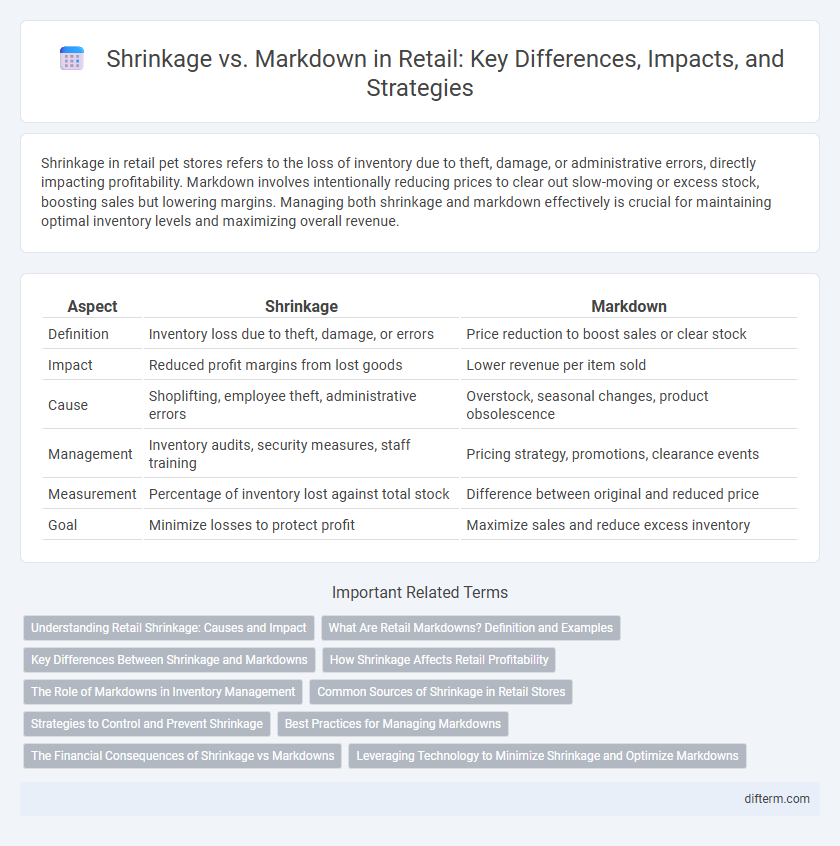Shrinkage in retail pet stores refers to the loss of inventory due to theft, damage, or administrative errors, directly impacting profitability. Markdown involves intentionally reducing prices to clear out slow-moving or excess stock, boosting sales but lowering margins. Managing both shrinkage and markdown effectively is crucial for maintaining optimal inventory levels and maximizing overall revenue.
Table of Comparison
| Aspect | Shrinkage | Markdown |
|---|---|---|
| Definition | Inventory loss due to theft, damage, or errors | Price reduction to boost sales or clear stock |
| Impact | Reduced profit margins from lost goods | Lower revenue per item sold |
| Cause | Shoplifting, employee theft, administrative errors | Overstock, seasonal changes, product obsolescence |
| Management | Inventory audits, security measures, staff training | Pricing strategy, promotions, clearance events |
| Measurement | Percentage of inventory lost against total stock | Difference between original and reduced price |
| Goal | Minimize losses to protect profit | Maximize sales and reduce excess inventory |
Understanding Retail Shrinkage: Causes and Impact
Retail shrinkage refers to the loss of inventory due to theft, administrative errors, and supplier fraud, significantly impacting profit margins. Unlike markdowns, which are intentional price reductions to stimulate sales or clear stock, shrinkage represents unplanned losses that erode retail revenue. Effective shrinkage control requires advanced inventory management systems and employee training to minimize these hidden costs and sustain operational profitability.
What Are Retail Markdowns? Definition and Examples
Retail markdowns refer to the deliberate reduction of product prices to stimulate sales, clear excess inventory, or respond to market demand fluctuations. Common examples include seasonal discounts, clearance sales, and promotional offers designed to enhance cash flow and reduce holding costs. Markdown strategies directly impact inventory turnover and can help minimize shrinkage by encouraging faster product movement.
Key Differences Between Shrinkage and Markdowns
Shrinkage in retail refers to the loss of inventory due to theft, damage, or administrative errors, directly impacting a store's profitability by reducing available stock without recorded sales. Markdowns involve intentional price reductions to clear out excess or outdated inventory, aiming to boost sales and turnover. While shrinkage represents unplanned financial loss, markdowns are strategic pricing decisions to manage inventory levels and maintain cash flow.
How Shrinkage Affects Retail Profitability
Shrinkage, which encompasses inventory loss due to theft, damage, or administrative errors, directly reduces retail profitability by decreasing the available sellable stock and inflating costs. Unlike markdowns that are strategic price reductions to boost sales or clear inventory, shrinkage represents unplanned losses that erode profit margins without generating revenue. Effective shrinkage control through loss prevention technologies and accurate inventory management can significantly enhance overall retail financial performance.
The Role of Markdowns in Inventory Management
Markdowns play a crucial role in inventory management by reducing shrinkage through price adjustments that accelerate sales and minimize excess stock. Effective markdown strategies help retailers clear slow-moving merchandise, freeing up shelf space and improving cash flow. Properly timed and data-driven markdowns mitigate losses from obsolescence and inventory holding costs, enhancing overall profitability.
Common Sources of Shrinkage in Retail Stores
Common sources of shrinkage in retail stores include employee theft, shoplifting, administrative errors, and supplier fraud, each contributing significantly to inventory loss. Inventory inaccuracies and damaged goods also play a crucial role in shrinkage, often leading to discrepancies during stock audits. Understanding these factors enables retailers to implement targeted loss prevention strategies and optimize inventory management.
Strategies to Control and Prevent Shrinkage
Effective strategies to control and prevent retail shrinkage include implementing advanced inventory management systems, conducting regular audits, and enhancing employee training programs to recognize and reduce theft. Utilizing technology such as RFID tagging and video surveillance helps monitor stock movement and deter shoplifting, while clear markdown policies minimize excess inventory that can contribute to shrinkage. Collaboration between loss prevention teams and store management is essential to identify vulnerabilities and enforce preventive measures consistently.
Best Practices for Managing Markdowns
Effective management of markdowns in retail requires accurate demand forecasting and real-time inventory tracking to minimize shrinkage and optimize profit margins. Implementing dynamic pricing strategies and leveraging data analytics help identify the right timing and depth of markdowns, reducing excess stock while maintaining customer satisfaction. Training staff on markdown protocols and integrating automated systems ensures consistency and accountability, ultimately enhancing overall shrinkage control.
The Financial Consequences of Shrinkage vs Markdowns
Shrinkage, including theft, administrative errors, and supplier fraud, directly reduces retail inventory value, causing financial losses typically ranging from 1-2% of sales, which significantly impacts profit margins. Markdowns, used as a strategic pricing tool to clear excess or seasonal stock, result in intentional revenue reduction but can improve cash flow and reduce carrying costs. The financial consequences of shrinkage are often unexpected and uncontrollable, leading to profit erosion, whereas markdowns represent planned losses that can be managed to optimize inventory turnover and overall financial performance.
Leveraging Technology to Minimize Shrinkage and Optimize Markdowns
Leveraging advanced analytics and AI-powered inventory management systems enables retailers to accurately track stock levels, reducing shrinkage caused by theft, errors, or spoilage. Implementing real-time data monitoring and predictive algorithms helps optimize markdown strategies by identifying slow-moving products and adjusting prices to maximize sales and profitability. Integrating these technologies enhances overall inventory accuracy, minimizes losses, and improves decision-making in retail operations.
shrinkage vs markdown Infographic

 difterm.com
difterm.com